Question 1 DemoAnswer: Letter | English Language for GCSE/IGCSE - Class 10 PDF Download
| Table of contents |

|
| Introduction |

|
| Addressing the reading assessment objectives |

|
| Planning your response |

|
| Letter model answer |

|
| Unannotated model answer |

|
| Summary |

|
Introduction
In this assignment, you'll craft a written piece in a specific format, drawing from the opinions, ideas, and information provided in one or two reading passages. Your writing might be in one of three potential formats or genres.
- A letter
- A speech
- An article
The following guide will demonstrate how to answer Question 1 in the format of a letter. The task itself is taken from a past exam paper. It includes:
- Addressing the reading assessment objectives
- Planning your response
- Letter model answer
- Unannotated model answer
- Summary
Addressing the reading assessment objectives
Up to 15 marks are available in this task for your ability to evaluate both the explicit and implied ideas, opinions, and attitudes expressed in one or two texts, and assimilate them to write a developed and sophisticated response.
Let's take a look at how you do this, using the following Question 1 example:

Your response here has to be based on the ideas, opinions, and attitudes contained in the following two texts:
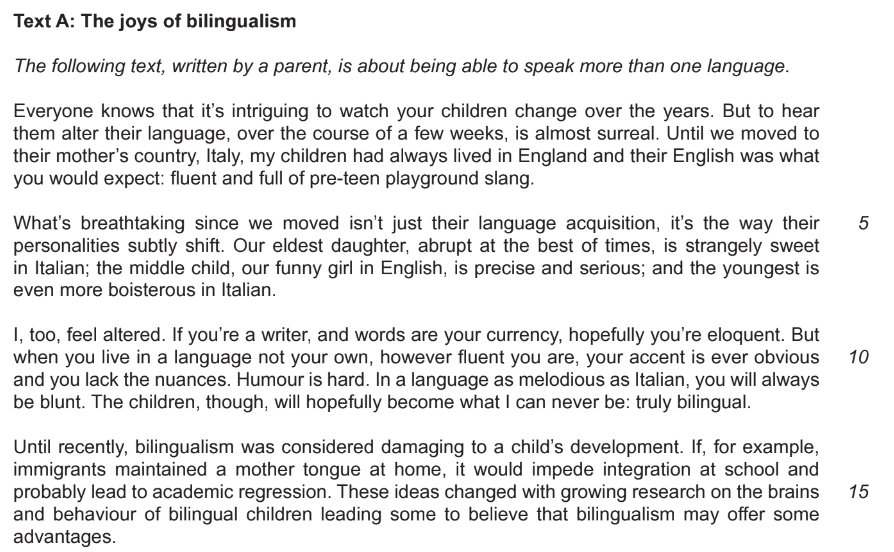


After carefully reading the task, you should read the texts and highlight the ideas and opinions that could inform your writing. Your response might use the following ideas from these texts:
Text A
- Youth, particularly "pre-teens," exhibit rapid language learning abilities.
- The adoption of new languages can lead to alterations in the personalities of young individuals.
- Mastering subtleties and humor expression in a new language poses a significant challenge.
- Debatably, achieving complete bilingualism may be unattainable.
- Notable accents are a common trait among bilingual individuals.
- Shifting perspectives on bilingualism have been influenced by ongoing research.
- Bilingualism fosters empathy and facilitates the adoption of diverse viewpoints.
- Evidence suggests that bilingualism may serve as a protective factor against dementia and promote cognitive flexibility.
- However, bilingualism could potentially hinder linguistic proficiency in both languages.
- Bilingualism serves as a source of enrichment, enhancing linguistic eloquence.
Text B
- Learning a second language may not always be a choice.
- Acquiring a new language can enhance your personality and make you more intriguing.
- Most bilingual individuals are not equally skilled in both languages, leading to occasional mistakes.
- Languages can fade from memory if not actively used.
- Being fluent in an additional language can increase your job prospects.
- Becoming truly fluent in multiple contexts is not always feasible.
- Maintaining proficiency in your native language helps preserve your cultural roots.
- Switching between languages can bring about changes in your personality and behavior.
Planning your response
Once you have completed reading the texts and have identified the relevant opinions, ideas, and attitudes, it is crucial to summarize these key points in your own words. Following this, allocate five minutes to strategize your written response. During the planning phase:
- Decide on your "voice" and point of view: Establish a clear perspective that reflects your interpretation of the text.
- Craft a statement summarizing your point of view based on your comprehension of the material.
- Jot down the points that can bolster your viewpoint in the initial paragraph of your response.
- Determine whether you will present a counter-argument and outline the supporting points for it.
- Revisit your primary argument, ensuring that it incorporates ideas and opinions from all relevant texts.
- Identify the key points to address the second bullet point in the given task.
- Outline your approach to commencing and concluding your response, guaranteeing that it sets the appropriate style and tone.
Letter model answer
The following exemplar showcases an outstanding response to the preceding task:
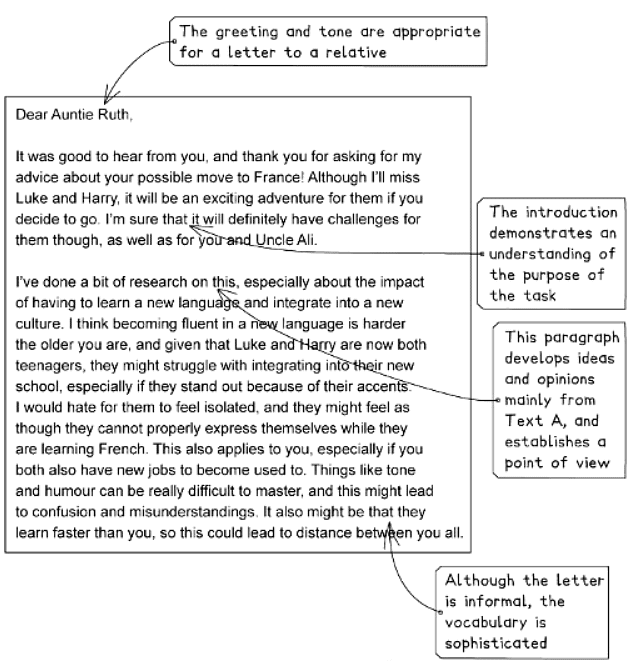
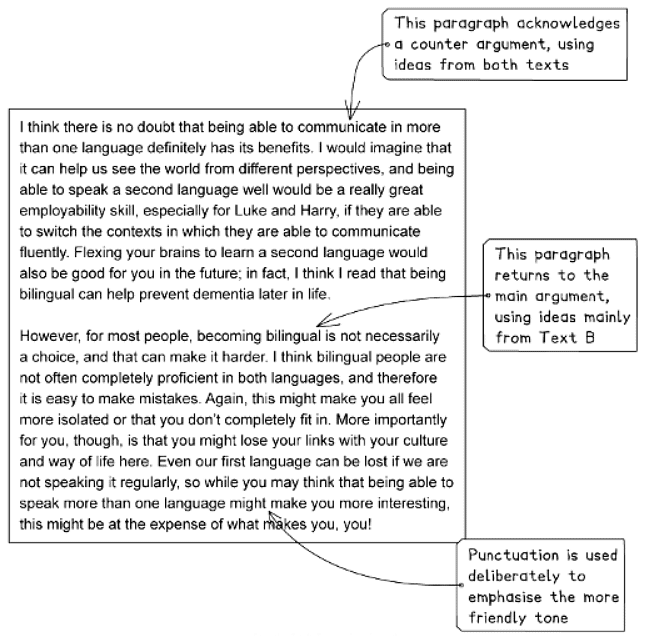
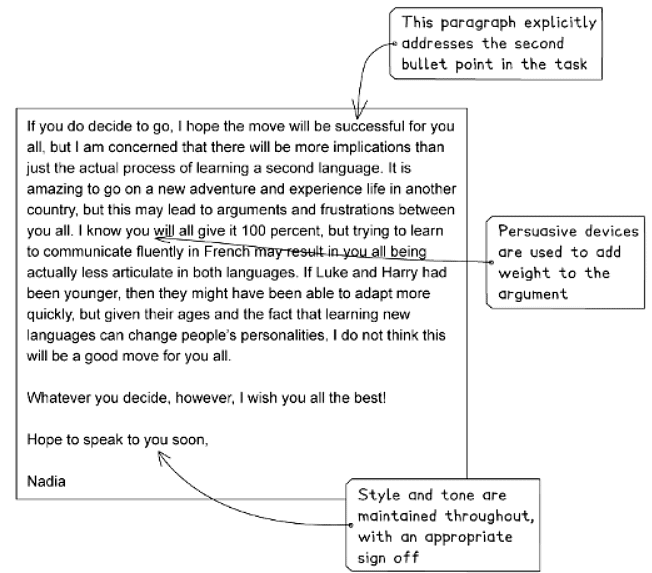
Unannotated model answer
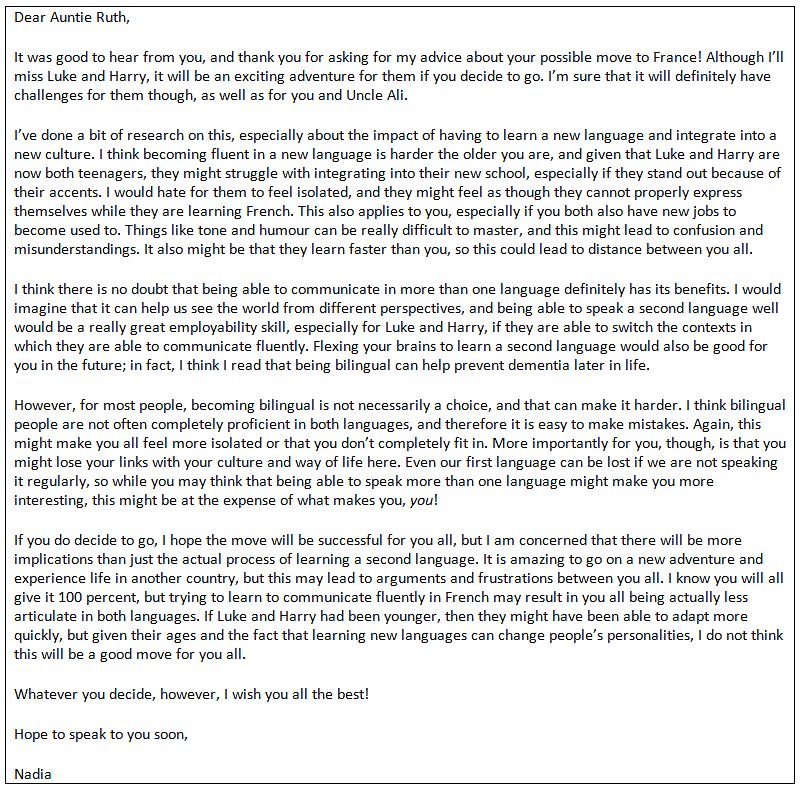
Commentary
- The greeting and tone are suitable for communicating with a family member.
- The introduction illustrates a grasp of the task's purpose.
- The second paragraph elaborates on ideas primarily from Text A, establishing a perspective.
- While maintaining an informal tone, the vocabulary used is sophisticated.
- The third paragraph acknowledges an opposing viewpoint by integrating ideas from both texts.
- The fourth paragraph revisits the main argument, drawing mainly from Text B.
- Punctuation is strategically employed to emphasize a friendly tone.
- The concluding paragraph explicitly addresses the second task requirement.
- Persuasive techniques enhance the argument's strength.
- Consistency in style and tone is maintained throughout, concluding with an appropriate closure.
- Accurate spelling, grammar, and punctuation are maintained consistently.
Summary
- What and Why:
- Identify the task: Producing a written piece in response to provided opinions, ideas, and information.
- Audience and purpose: Specified in the task instructions.
- Bullet Points Focus:
- Highlight each bullet point's main focus to address them effectively.
- Ensure equal coverage of all bullet points.
- Relevant Information from Text(s):
- Extract and highlight ideas, opinions, and information from the text(s) that could be expanded upon in the response.
- Summarize this information in your own words.
- Planning:
- Focus on one central idea or opinion per paragraph.
- Plan the structure of the response accordingly.
- Addressing Bullet Points:
- Address each bullet point sequentially.
- Provide balanced coverage of all points.
- Voice and Style:
- Choose a consistent voice and style appropriate for the task's purpose and audience.
- Maintain this voice and style throughout the response.
- Evaluation and Development:
- Avoid mere repetition of text details.
- Evaluate and expand upon the ideas, opinions, and attitudes presented in the text(s) to provide a nuanced response.
|
16 videos|45 docs
|
FAQs on Question 1 DemoAnswer: Letter - English Language for GCSE/IGCSE - Class 10
| 1. What are the main themes discussed in the article? |  |
| 2. How does the article address the issue of privacy in relation to technology? |  |
| 3. What are some examples of emerging technologies mentioned in the article? |  |
| 4. How does the article suggest individuals can stay informed and educated about technological developments? |  |
| 5. What are some potential challenges that society may face as a result of technological advancements, according to the article? |  |



















